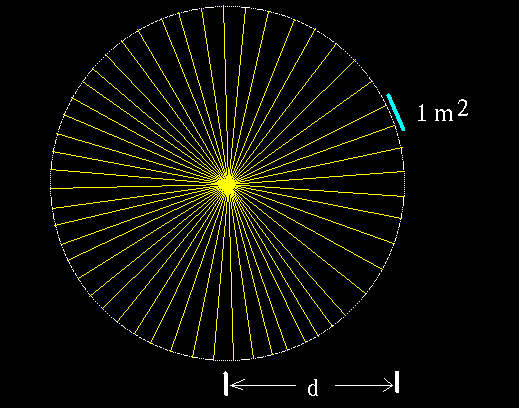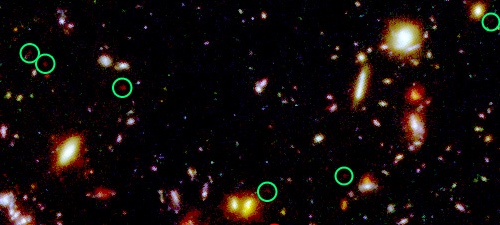"What do we mean by setting a man free? You cannot free a man who dwells in a desert and is an unfeeling brute. There is no liberty except the liberty of some one making his way towards something. Such a man can be set free if you will teach him the meaning of thirst, and how to trace a path to a well. Only then will he embark upon a course of action that will not be without significance. You could not liberate a stone if there were no law of gravity -- for where will the stone go, once it is quarried?" -Antoine de Saint-Exupery
Gravity, on the largest scales, rules everything in the Universe. You and I -- and everything else in our galaxy -- started as tiny fluctuations in the young Universe, where maybe we were only 0.001% denser than average, represented by the blue spots, below.
Thanks to the power of gravity, this little bit of extra mass is better at attracting the mass around it than other places, and pulls it in on itself. Over time, as it gathers more and more of the mass around it, matter begins to collapse, forming galaxies, stars, and eventually, things like you and me.
But how far back can we see? Normally, when we look places in the night sky, all sorts of relatively nearby things are in the way.
Stars, dust, gas, nebulae, and (relatively) nearby galaxies all get in the way of our attempts to look as far as possible into the distant Universe. But we've gone and found a few patches in the sky with no bright stars, no gas, very little dust, and no close-or-intermediate-distance galaxies. And for a few of them, we've pointed our favorite telescope at them.

I'm talking about the Hubble Space Telescope, of course! Capable of seeing almost exactly the same wavelengths of light that our eyes can, the Hubble Space Telescope spent literally days staring at the same blank patch of sky, collecting single photons one-at-a-time. And after enough days had passed by, this is what it found.
This image -- known as the Hubble Ultra Deep Field -- contains about 10,000 very distant galaxies. And honestly, it probably contains more that are even more distant, but invisible to us. Why's that? There are actually two reasons.

First off, the farther away from something you are, the dimmer it appears. This is actually severe; if something's twice as far away, it's going to appear just one-fourth as bright, and if it's four times as far away, it'll be only one-sixteenth as bright! So for the most distant objects, even days of observing are enough to get only some of the very brightest ones.
But there's a second reason, too.
Wavelength. You know, since the Universe is expanding, that the farther away an object is, the redder its light appears to us. At some point, you're looking at objects so far away that all of the visible light gets shifted into the infrared part of the spectrum, and becomes invisible to us!

So when we look in detail at this image, we're able to find some extremely faint, and very, very red objects. They're not only located all over the place,

but they're also located in very close proximity to much closer, brighter, less red galaxies! Why is that? Well, my friends, this is why gravity is the telescope's best friend!

Out in space, gravity from massive galaxies acts like a magnifying lens, making galaxies that would otherwise be too dim appear brighter and, in many cases, larger, allowing us to see them!
These galaxies, circled above, are the most distant ones ever discovered, with a measured redshift of eight, meaning that the visible, red light we see was emitted as extreme ultraviolet light, and the expanding Universe has moved it out of the ultraviolet, past violet, blue, green, yellow, orange, and almost into the infrared by time it reaches our eyes! A galaxy at a redshift of eight, for those interested, corresponds to looking at them when the Universe was only 600 million years old; more than 13 billion years ago.

But there's more. In addition to the ultra-red galaxies, circled in green, scientists have also identified purely infrared candidates, invisible to our eyes, circled in red above.
How would we confirm something so distant that the light from it is invisible to our eyes?

You build a deep space telescope with infrared eyes, which is exactly what the James Webb Space Telescope, Hubble's successor, is going to be!
It's wonderful that Hubble is giving us hints of this now, but I can hardly wait to see what the next generation of space telescopes will teach us about the Universe. In the meantime, the extra magnifying glass of gravity is our only hope!






I friggin love this blog
+1
Ethan, it would be awesome if you did a post on the James Webb Space Telescope and describe in your style what we can expect from it, and maybe what potential surprises we could discover.
It seems Hubble had some early surprises: http://query.nytimes.com/gst/fullpage.html?res=9E0CE5D91F3AF937A25752C0…
Ethan, thanks for this wonderful blog. I really like you blog.
Yet again demonstrating why this is one of the best science blogs on the 'Net. Your enthusiasm and passion for science are contagious.
WOW That sucker is going to be way out there. Anyone know how long it will take for the JWST to make the trip after launch? I tried to find it but I don't think most people care.
I absolutely can't wait to see what is even further out there.. I am 69 yes young and am an old sci-fi
Fan. Probably for the last 40!or more years, but no one has come close to the writers that were the
Biggies of the 50's and 60's. If you can recommend a writer that can write something like "A Mote In
God's Eye". Please tell me. I am not interested in "fantasy" dragons or other world cultures. Just give me a spaceship that has a human brain or time jumpers who save the world. Any suggestions in those areas are hoped for. Love, y
Hi
If e.m. is 10...38th power stronger than gravity, why is there
no attempt to use e.m. in explanation of Space/planetary et al
behaviour? How does Gravity overrule?
I am a loyal Pharyngula reader and have always described that blog to my friends and colleagues as the "best science blog" on the interwebs. Gradually I have been coming around to the notion that Starts With a Bang is actually the best. Today I had my final revelation: SWAB really **IS** the best. These posts are so clear and the images so wonderful and well chosen, I don't think I have ever come across popular science writing as superb as this (and I've read a LOT in the genre).
Hi Ethan,
I would like to share with you a comparison study between some space facts and verses in the holy Quran describing Universe creation on my blog:
"http://debatewithatheist.blogspot.com/2011/01/story-of-creation-1-how-w…"
Since you are an expert I would like a lot to know your opinion. Believe me the subject is very interesting and you may be astonished ...
Note, I copied one of your marvelous images in my article, thanks,